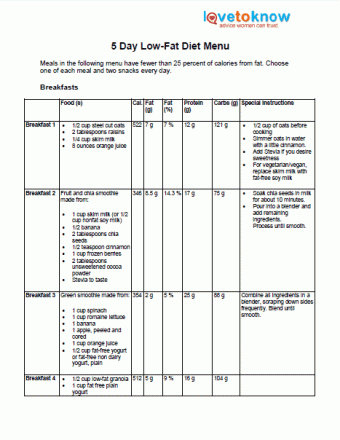

Navigating Lean Living: Your Guide to a Low-Fat Diet
Embarking on a Low-Fat Diet Plan involves strategic choices to reduce dietary fat intake for improved health and weight management. In this comprehensive guide, we explore the principles, benefits, and practical strategies to adopt a low-fat lifestyle.
Understanding the Principles of a Low-Fat Diet
A Low-Fat Diet focuses on limiting the consumption of dietary fats, particularly saturated and trans fats. The goal is to promote heart health, reduce the risk of chronic diseases, and manage weight. Key sources of healthy fats, such as those found in avocados, nuts, and olive oil, are retained while minimizing processed and high-fat foods.
Balancing Macronutrients for Optimal Health
While reducing fat intake, it’s crucial to maintain a balanced intake of macronutrients. A Low-Fat Diet emphasizes the importance of obtaining sufficient carbohydrates, proteins, and essential vitamins and minerals. A well-rounded approach ensures the body receives adequate nutrition for overall health and energy.
Benefits of a Low-Fat Lifestyle
- Heart Health: Lowering saturated fat intake supports cardiovascular health by reducing cholesterol levels and promoting healthy blood vessels.
- Weight Management: A Low-Fat Diet can contribute to weight loss and weight maintenance, especially when combined with a calorie-controlled approach.
- Reduced Disease Risk: Lower fat consumption is associated with a decreased risk of certain chronic diseases, including heart disease, diabetes, and certain cancers.
Navigating Food Choices in a Low-Fat Diet
- Lean Proteins: Choose lean protein sources such as poultry, fish, beans, and legumes to minimize fat intake while meeting protein needs.
- Whole Grains: Opt for whole grains like brown rice, quinoa, and whole wheat, providing fiber and essential nutrients without excessive fat.
- Fruits and Vegetables: Load up on colorful fruits and vegetables for vitamins, minerals, and antioxidants with negligible fat content.
- Dairy Alternatives: Select low-fat or fat-free dairy options to enjoy the benefits of calcium and other nutrients without excess saturated fat.
Practical Strategies for a Low-Fat Lifestyle
- Smart Cooking Methods: Use cooking methods like grilling, steaming, and baking instead of frying to minimize added fats.
- Read Food Labels: Be vigilant about reading food labels to identify hidden fats and make informed choices while grocery shopping.
- Portion Control: Practice portion control to manage calorie intake, even with low-fat foods, and avoid overeating.
Overcoming Challenges and Myths
Addressing common challenges and dispelling myths associated with a Low-Fat Diet is essential. Contrary to the misconception that all fats are unhealthy, incorporating healthy fats in moderation is crucial for overall well-being. Additionally, understanding that not all low-fat products are healthy is key; some may contain added sugars or processed ingredients.
Creating Sustainable Habits for Long-Term Success
The key to long-term success on a Low-Fat Diet lies in creating sustainable habits. Rather than viewing it as a short-term solution, approach it as a lifestyle change. Incorporating enjoyable low-fat recipes, exploring diverse food options, and finding a balance that works for your individual preferences contribute to sustained success.
Low-Fat Diet Plan: A Path to Optimal Health
In conclusion, adopting a Low-Fat Diet Plan is a strategic approach to promoting health and well-being. Understanding the principles, making informed food choices, and embracing practical strategies contribute to a balanced and sustainable low-fat lifestyle. To explore more about Low-Fat Diet Plans and their impact on health, visit CloudFeed.
